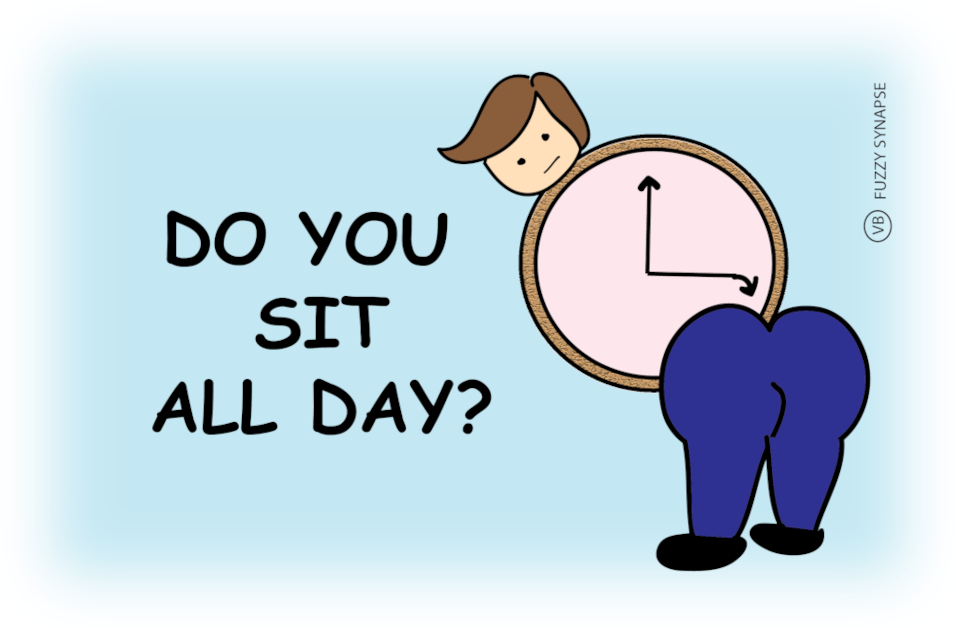
More and more of us spend a significant portion of our day on our butts. Of course increasing your daily activity is important, but what are some small actions you can do outside of daily exercise?
I admit this is not my area of expertise, but I’ve spent some time looking into various methods and thought I would share my ideas on sitting, without just sitting. You might be asking “what on earth do you mean!?”, which is probably reasonable. I don’t have data to back up my claims (and yes as a scientist, I need to clarify this point!), but what I mean is a way to be active while sitting (if only marginally so).
I’m going to skip over the non-stationary activities. Such as: regular exercise, getting up frequently, moving around and stretching whenever you don’t absolutely have to stay in one place. As these are things you’re likely already aware of and hopefully doing – if not, than hint, hint!
My thoughts on ‘active-sitting’:
- Balance ball. I have one myself, but I’ve never tried sitting at my desk on a balance ball – I’m pretty sure I’d be too low. There are ‘chairs’ that you can put the balance ball on, so that might help. The ‘chair’ can also be somewhat more pricey than other options. Or there’s a ring that can be placed under the ball, but again I personally think I’d be too low, not to mention the loss of balancing-activity and fun you additionally lose.
- My new favourite is a balance disc. The balance disc is essentially the same idea as the balance ball, but you can just place it on top of your desk chair (which I’m doing as I write this!). Some of the benefits of using a balance disc (and even more so with the balance ball), is actively using your abdominals, back muscles, and I think even glutes, to maintain an upright position. Potentially improving your posture and reducing the pressure on your tailbone! There’s also the added ‘fun’ for those who tend to move a lot – which is limited when sitting on a stationary and flat seat.
- I haven’t tried this myself, but there’s also the seated bicycle or elliptical contraption that can be used while sitting. I think the ease of use would depend on your physical stature – if you have long legs, I suspect you would have more difficulties using one under a desk. Alternatively, I’ve also seen bicycle desks.
- Then there’s standing desks. I personally don’t have one (as I don’t currently have the funds or space to invest), but a standing desk can consist of either a device you place on your desk surface to elevate your work station, full desks that you stand at, or even desks that can switch between sitting and standing. As an added activity boost, you could stand on a balance board, or even a balance disc. All of which are going to vary in costs, but there are a range of options available. These of course remove the ‘sit’ from working, so the ‘active-sitting’ benefits should be rather obvious…
- One step above a standing desk is the ‘walking desk’. Again, there are a range of ways in which you can accomplish this: a tall/standing desk with a treadmill, or there’s a separate treadmill that can be positioned under a standing desk. No matter which way you go, this is going to be a more pricey option (and likely require some practice), but it would definitely add activity!
- An additional way to include activity while sitting, would involve having (at least some) hands-free work – such as if you read a lot, or watch videos (as part of work training/learning, or professional seminars or webinars, etc). Some examples would be stress balls that you squeeze (probably useful for de-stressing as well!), or even gyroscopic balls (which involves you fighting centrifugal forces to hold and work the ball). I recently acquired a gyroscopic ball myself – until you really get a feel for using one, you need to split focus a bit – but they’re quite fun to use!
I have doubts on how much activity most of these actually add to sitting, but given the potential issues associated with sitting for extended periods of time, every day, my thinking is — include as much activity as you can, when you can!
About the Author
Lisa A. Boughner received her PhD in biology from Louisiana State University in 2013. She then worked at Michigan State University as a postdoctoral researcher for nearly 5 years, before deciding to blaze her own trail in science communication. During her postdoctoral experience, she discovered her knack for advocating and leading others – both as Chair of MSU’s Postdoctoral Association, as part of the National Postdoctoral Association’s Meetings Committee, and as a mentor to undergraduate students.